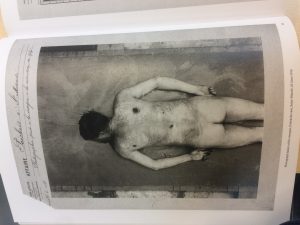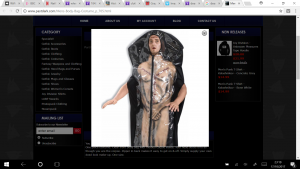My chosen image is a photograph of a dead body that was taken at a morgue, Poeckoes case, Saint-Mande on the 25th June 1913. The body appears to have had suffered injuries to the back which we can assume from the title of the book, “Images of Conviction. The Construction of Visual Evidence”, played a role in this body’s death.
This photo is taken out of a police report back in 1913. According to the website: http://deskarati.com/2013/03/04/history-of-forensic-photography/, forensic photography only became more mainstream in larger cities in the 1870s, therefore making this photograph a relatively new practice of criminal evidence. This photo would have been taken so to document the body and all the clues it may show, before it begins to decompose and change.
(http://www.pastdark.com/Mens-Body-Bag-Costume_p_705.html)
This photograph is of a Halloween Costume of a man in a body bag. Images of death are closely related to the theme of Halloween and here is intended to make light of a scenario similar to one In the original picture. Here too the body is naked and has surface wounds. The naked body is clearly an important aspect to the image and its functionality which would be to investigate the cause of death. However, this costume is currently on the market in 2017 which is over 100 years the future of the original photograph so we cannot assume the markings on this body is still commonplace today. This photo is also for a commercial use and is suggested to be comedic so trusting the details in the costume would not be completely advisable.
The Science Museum Brought to Life ‘exploring the history of medicine’ identifies a man named Alphonse Bertillon who was alive from 1853 until 1914, so just encompassing the year of the morgue photograph. He tried to identify criminals through their physical features. Using photographs he would document person marks that wouldn’t change such as the eye colour or tattoos.
In the online archive “Nature” there is an article called “the scene of the crime: Rodolphe A. Reiss (1875-1929)” this depicts a man they refer to as a “pioneer of forensic photography”. He apparently left all details from his images so the viewer must look at the image objectively as it is the only source of information and to see what evidence they can find. These images are currently on display in Lausanne’s Elysee Museum, however the exhibition comes with a warning as these images are too graphic for the feint hearted and children as they come from real life with nothing hidden as these were designed for function.
Ive started with this source because topics such as crime and death will always be relevant. As Halloween is coming up, images of fake horror and comedic wounds are everywhere and this doesn’t represent real life. I have discovered more about how far an image can actually take you in multiple directions from the smallest of details if you look for the right things.


